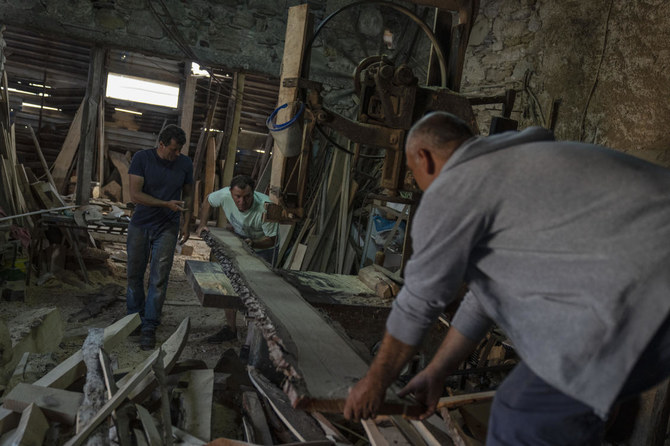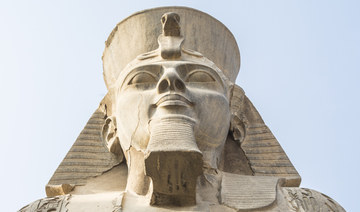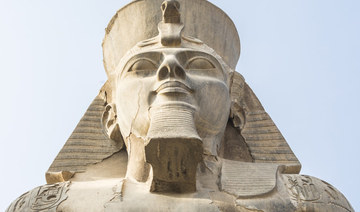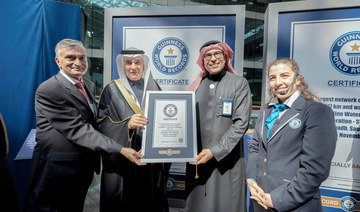DRAKAIOI, Greece: On the forested slopes of an island mountain, early morning mist swirling around its peak, the unmistakable form of a traditional Greek wooden boat emerges: a caique, or kaiki, the likes of which has sailed these seas for hundreds of years.
Each beam of wood, each plank, has been felled, trimmed and shaped by one man alone, hauled and nailed into place using techniques handed down through generations, from father to son, uncle to nephew. But the current generation could be the last.
Wooden boats are an integral part of the Greek landscape, adorning tourist brochures, postcards and countless holiday snaps. They have been sailing across Greece for centuries, used as fishing boats, to transport cargo, livestock and passengers and as pleasure craft.
But the art of designing and building these vessels, done entirely by hand, is under threat. Fewer people order wooden boats since plastic and fiberglass ones are cheaper to maintain. And young people aren’t as interested in joining a profession that requires years of apprenticeship, is physically and mentally draining and has an uncertain future.
“Unfortunately, I see the profession slowly dying,” said Giorgos Kiassos, one of the last remaining boatbuilders on Samos, an eastern Aegean island that was once a major production center.
“If something doesn’t change, there will come a time when there won’t be anyone left doing this type of job. And it’s a pity, a real pity,” Kiassos said during a brief break in his mountain boatyard where, between walnut and wild mulberry trees, he is working on two: a 14-meter (45-foot) pleasure craft and a 10-meter (about a 30-foot) fishing boat.
The boats are being made to order, with the bigger one costing around 60,000 euros ($70,000), and the smaller one around 30,000 euros ($35,000).
Samos caiques are famed both for their workmanship and their raw material: timber from a pine species whose high resin content makes it durable and more resistant to woodworm. A few decades ago, numerous boatyards dotted the island, providing a major source of employment and sustaining entire communities. Now there are only about four left.
“Yes, it’s an art, but it’s also heavy work, it’s tough work. It’s manual labor that’s tiring, and now the young people, none of them are following,” Kiassos said. He’s encouraged his 23-year-old son to learn, but he isn’t particularly interested. He hopes to become a merchant captain instead.
Kostas Damianidis, an architect with a Ph.D. on Greek traditional boatbuilding, said there are several reasons for the dramatic decline in shipwrights, or traditional boatbuilders, throughout Greece.
“It is a traditional craft which is slowly dying, and yet it’s treated as if it were a simple manufacturing or supply business. There is no support from the state,” he said.
What’s more, for years the European Union, of which Greece is a member, has subsidized the physical destruction of these vessels as a way of reducing the country’s fishing fleet. The practice has led to thousands of traditional fishing boats, some described by conservationists as unique works of art, being smashed by bulldozers.
The policy is “a big blow to wooden shipbuilding,” Damianidis said. “They might be old boats, but this is a disdain of the craft. When a young person sees that they’re smashing wooden boats as useless things, why should they bother to learn how to make them?”
For their creators, the destruction is heartbreaking.
“It’s a bad thing, very bad. Because this art is one of the best and one of the most difficult. An ancient art,” retired boatbuilder Giorgos Tsinidelos said. Now 75, he started working at the age of 12 at his grandfather’s boatyard on Samos. He spent years as an apprentice before moving to the major shipbuilding area of Perama, near Greece’s main port of Piraeus.
“You don’t learn this job in a year or two. It takes many years,” he said. “Don’t forget that you take wood and you create a masterpiece, a boat.”
Another major factor in the rapidly dwindling number of shipwrights is the lack of any formal education.
“Young people have to go learn beside the old craftsmen, often for five years, six years, for them to be able to make a small boat, a kaiki, themselves,” Damianidis said. “There is no boatbuilding school.”
Damianidis is the curator of a new museum of Aegean Boatbuilding and Maritime Crafts being set up on Samos, and hopes a traditional boatbuilding school, which would be Greece’s first, will open in the museum.
That could also help Samos’ last boatbuilders, who now work mainly alone due to a shortage of skilled assistants.
“It’s important to have someone experienced because if you make one mistake, especially in the first stages of (building) the boat, the boat might end up being — well, more of a basin than a boat,” chuckled Kiassos.
Like Tsinidelos and all the current boatbuilders, Kiassos started young. Now 47, he’s been working for more than 30 years but says he’s still learning. As a schoolboy, he would sit in his uncle’s boatyard, watching logs morph into beautiful vessels. He began working there at 16 while finishing school.
He learned when the right season is to fell the trees — when to use naturally curved timber, and where on the boat each piece should go. Get that wrong, and the vessel could end up with problems, he explains. Get it right, and his creation combines beauty, function and durability.
The time and effort that goes into production means boatbuilders often form a bond with their creations, and eventually delivering them to their owners is often bittersweet.
Kiassos says he’s eager to finish each boat and start on the next.
“But when it leaves, I’m somehow sad. Yes, I’ll be happy when I see it in the water and I see everything is OK, but it’s like something is leaving — like a piece of me, how can I say it?” He grasps for words. “It might sound a bit strange the way I’m saying it, but that’s how it is.”
Despite the bleak outlook for his profession’s future, another Samos boatbuilder, 45-year-old Andreas Karamanolis, remains hopeful.
“I believe that people will return to the wooden boat. I want to believe it. Because the truth is, no other boat has the durability of the wooden boat. Not the plastic ones, not any of them,” he said. “Wood is a living organism, which no matter how many years you use it, it continues to be alive.”
Greek traditional wooden boat builders a dwindling craft
https://arab.news/5fb97
Greek traditional wooden boat builders a dwindling craft

- The time and effort that goes into production means boatbuilders often form a bond with their creations
Egypt reclaims 3,400-year-old stolen statue of King Ramses II

- Egyptian authorities spotted the artefact when it was offered for sale in an exhibition in London in 2013
CAIRO: Egypt welcomed home a 3,400-year-old statue depicting the head of King Ramses II after it was stolen and smuggled out of the country more than three decades ago, the country’s antiquities ministry said on Sunday.
The statue is now in the Egyptian Museum in Cairo but not on display. The artefact will be restored, the ministry said in a statement.
The statue was stolen from the Ramses II temple in the ancient city of Abydos in Southern Egypt more than three decades ago. The exact date is not known, but Shaaban Abdel Gawad, who heads Egypt’s antiquities repatriation department, said the piece is estimated to have been stolen in the late 1980s or early 1990s.
Egyptian authorities spotted the artefact when it was offered for sale in an exhibition in London in 2013. It moved to several other countries before reaching Switzerland, according to the antiquities ministry.
“This head is part of a group of statues depicting King Ramses II seated alongside a number of Egyptian deities,” Abdel Gawad said.
Ramses II is one of ancient Egypt’s most powerful pharaohs. Also known as Ramses the Great, he was the third pharaoh of the Nineteenth Dynasty of Egypt and ruled from 1279 to 1213 B.C.
Egypt collaborated with Swiss authorities to establish its rightful ownership. Switzerland handed over the statue to the Egyptian embassy in Bern last year, but it was only recently that Egypt brought the artefact home.
A Nigerian chess champion is trying to break the world record for the longest chess marathon

- Tunde Onakoya, 29, is playing against Shawn Martinez, an American chess champion, in line with Guinness World Record
- Onakoya, who founded Chess in Slums Africa, hopes to raise $1 million for children’s education across Africa
NEW YORK: A Nigerian chess champion and child education advocate is attempting to play chess nonstop for 58 hours in New York City’s Times Square to break the global record for the longest chess marathon.
Tunde Onakoya, 29, hopes to raise $1 million for children’s education across Africa. He is playing against Shawn Martinez, an American chess champion, in line with Guinness World Record guidelines that any attempt to break the record must be made by two players who would play continuously for the entire duration.
Onakoya had played chess for 42 hours by 10:00 a.m. GMT on Friday. Support is growing online and at the scene, where a blend of African music is keeping onlookers and supporters entertained amid cheers and applause.
The current chess marathon record is 56 hours, 9 minutes and 37 seconds, achieved in 2018 by Hallvard Haug Flatebø and Sjur Ferkingstad, both from Norway.
The record attempt is “for the dreams of millions of children across Africa without access to education,” said Onakoya, who founded Chess in Slums Africa in 2018. The organization wants to support education of at least 1 million children in slums across the continent.
“My energy is at 100 percent right now because my people are here supporting me with music,” Onakoya said Thursday evening after the players crossed the 24-hour mark.
On Onakoya’s menu: Lots of water and jollof rice, one of West Africa’s best known dishes.
For every hour of game played, Onakoya and his opponent get only five minutes’ break. The breaks are sometimes grouped together, and Onakoya uses them to catch up with Nigerians and New Yorkers cheering him on. He even joins in with their dancing sometimes.
A total of $22,000 was raised within the first 20 hours of the attempt, said Taiwo Adeyemi, Onakoya’s manager.
“The support has been overwhelming from Nigerians in the US, global leaders, celebrities and hundreds of passersby,” he said.
Onakoya’s attempt is closely followed in Nigeria where he regularly organizes chess competitions for young people living on the streets to boost his cause. More than 10 million children are out of school in the West African country — one of the world’s highest rates.
Among those who have publicly supported him are celebrities and public office holders, including Nigeria’s former Vice President Yemi Osinbajo, who wrote to Onakoya on X, formerly Twitter: “Remember your own powerful words: ‘It is possible to do great things from a small place.’“
The Guinness World Record organization has yet to publicly comment about Onakoya’s attempt, which could reach 58 hours by midnight on Friday. It sometimes takes weeks for the organization to confirm any new record.
Used missiles for sale: Iranian weapons used against Israel are up for grabs on Jordan-based website
Used missiles for sale: Iranian weapons used against Israel are up for grabs on Jordan-based website

- Debris used in attack listed on OpenSooq online marketplace
LONDON: Fragments of missiles launched by Iran during the recent attack on Israel have been discovered for sale on Jordan’s prominent OpenSooq website, which is known for trading goods, including vehicles and real estate.
Al Arabiya reported on Sunday that the shrapnel was being advertised, with pieces described as “Used Iranian ballistic missile in good condition for sale,” and “One-time use ballistic missile for sale at an attractive price.”
The sellers had provided specifications and images of the missiles, describing them as “excellent type,” and mentioned their involvement in an “accident” resulting in “severe damage to the body.”
Some listings even included installment payment options.
Iran launched drones and missiles toward Israel late on Saturday as it retaliated following a suspected Israeli strike on the consulate annex building adjacent to the Iranian Embassy in Damascus, Syria, earlier this month.
While most projectiles were intercepted by a joint response from Israel, the US, UK, France, and Jordan, the attack marked Iran’s first direct military assault on Israeli territory, escalating tension and uncertainty in the region.
Following the attack, individuals shared photographs online showing debris that had fallen on Jordanian territory in areas such as Al-Hasa, Marj Al-Hamam, and Karak Governorate.
The Jordanian government confirmed that it had intercepted some flying objects in its airspace, with no reported damage or injuries.
Debris from such incidents often holds economic value. Metal debris from the Iraq War has been used by Iran-backed groups to finance their activities.
Similar items are sold online as military memorabilia, and there has been a surge in demand for such artifacts, as seen in Australia last year, preceding the country’s ban on the sale of hate symbols.
Google Doodle celebrates Lebanese-American poet and artist Etel Adnan

- Etel Adnan rose to fame for her 1977 novel Sitt Marie Rose about the Lebanese civil war
DUBAI: Google released its latest Doodle on Monday honoring Etel Adnan, a Lebanese-American poet, essayist and visual artist, considered one of the most accomplished Arab-American authors of her era.
The poet, who rose to fame for her 1977 novel Sitt Marie Rose about the Lebanese civil war, was born in Lebanon in 1925 to a Greek mother and a Syrian father, and grew up in multiple cultures, languages, nationalities and religions. Sitt Marie Rose won the France-Pays Arabes award and become a classic of war literature, so much so that it is taught in American classrooms.
In 1949, Adnan went to Paris to study philosophy at the Sorbonne before going to America to study at Harvard and Berkeley.
From 1958 to 1972, she taught philosophy in California, during which time she also started painting and writing poetry. She developed her literary voice in English and said abstract painting was the entry point into her native Arabic.
Adnan returned to Beirut, where from 1972 to 1976 she worked as the arts editor for two newspapers. She returned to California in 1979, then spent her later years living between Paris and Beirut.
In 2003, Adnan was named “arguably the most celebrated and accomplished Arab American author writing today” by the academic journal MELUS: Multi-Ethnic Literature of the United States.
Adnan’s most recent honor was in 2020. Her poetry collection “Time,” which is a selection of her work — translated from French by Sarah Riggs — won the Griffin Poetry Prize.
The King Abdulaziz Center for World Culture, or Ithra, earlier this year opened an eponymous exhibition in her honor – “Etel Adnan: Between East and West” – showcasing 41 of her works. The space at Ithra’s gallery is the first solo exhibition of Adnan’s work in Saudi Arabia, running until June 30.
The works on display span from the beginning of Adnan’s artistic career in the late 1950s through to her final creations in 2021, shortly before her death that year aged 96.
Some of the works are on loan from significant international institutions such as the Sharjah Art Foundation, Sfier-Semler Gallery and Sursock Museum. Some are part of private collections.
‘HELP’ written in palm fronds lands rescue for Pacific castaways

- The trio became stranded on Pikelot Atoll, a tiny island in the remote Western Pacific, after their motor-powered skiff malfunctioned
- A US Navy aircraft saw the "help" sign and a ship came later to rescue the stranded trio, all experienced mariners in their 40s
LOS ANGELES: Sometimes all you have to do is ask for “HELP“: That’s what three men stranded on a deserted Pacific island learned earlier this week, writing the message in palm fronds which were spotted by US rescuers.
The trio, all experienced mariners in their 40s, became stranded on a lonely island after setting off from Micronesia’s Polowat Atoll on March 31 in their motor-powered skiff which subsequently experienced damage.
They were reported missing last Saturday by a woman who told the US Coast Guard her three uncles never returned from Pikelot Atoll, a tiny island in the remote Western Pacific.
“In a remarkable testament to their will to be found, the mariners spelled out ‘HELP’ on the beach using palm leaves, a crucial factor in their discovery,” said search and rescue mission coordinator Lt. Chelsea Garcia.
She reported that the trio was discovered Sunday on Pikelot Atoll by a US Navy aircraft.
“This act of ingenuity was pivotal in guiding rescue efforts directly to their location,” she said.
The aircraft crew dropped survival packages, and rescuers one day later dropped a radio which the mariners used to communicate that they were in good health, had access to food and water, and that the motor on their 20-foot (six-meter) skiff was no longer working.
On Tuesday morning a ship rescued the trio and their equipment, returning them to Polowat Atoll, the Coast Guard said.
In August 2020, three Micronesian sailors also stranded on Pikelot were rescued after Australian and US warplanes spotted a giant “SOS” they had scrawled on the beach.




















